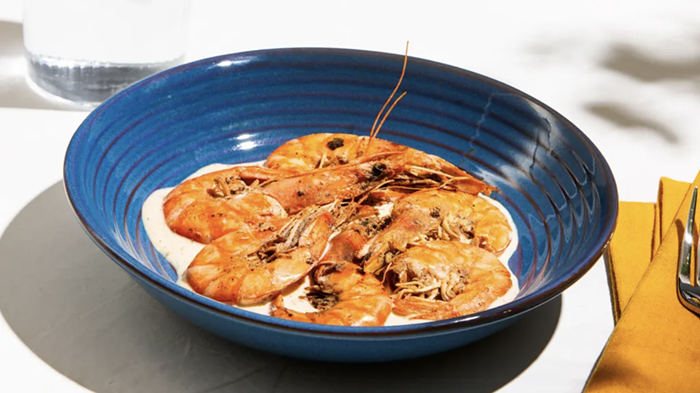The Bug Chef arrives with his own FryDaddy deep fryer. He's going to make tempura tarantula. Also on the menu: orzo pasta with peppers and crickets. He likes to go light on the seasonings so you can taste the bugs. "We're cooking about 150 crickets," he says, unveiling a dead bowlful. Then he unwraps the tarantula and arranges it with care on a brightly colored plate. The spider is brown and velvety and appears very much alive, like it might start crawling at any moment. It's dead, too. He kills the bugs he cooks by freezing them; they're cold-blooded, and they just slow down until they stop. In the case of the crickets, he buys them from a biological supply company, so, he says, he's actually saving them from a life of slow torture at the hands of science. For the 10th Annual Bug Blast on Sunday, September 28, at the Burke Museum, he'll cook a couple thousand crickets, sticking the whole boxful in the freezer ahead of time.
David George Gordon's business card says "Author, Lecturer, Bug Chef." Into the first category fall his seminal works The Compleat Cockroach and The Eat a Bug Cookbook, as well as 10 other books of biology. (The Cookbook is dedicated "To Stuart, who showed me that gross can be good." Stuart is his brother, a horror-movie director best known for Re-Animator.) The lecturing and the bug-chefing go together at events like the Burke's Bug Blast or for the employees of Terminex.
Gordon has been taking his show on the road for 10 years. Tonight he's made a house call for a private preview. He puts on an apron and an irretrievably goofy chef's hat with antennae attached to it. He looks like Richard Dreyfuss. As far as wine pairings, he recommends sauvignon blanc, pinot gris, or any wine that goes well with crustaceans to accompany their relatives on land. He accepts a glass of French chardonnay with alacrity.
He's all about mise en place; everything is prepped, and he talks as he sets it all out. For the Orthopteran Orzo, the orzo is precooked and mixed with diced red and green pepper. He's brought a wok, the fast heat of which is best for crickets (if overcooked, the pressure builds up inside their exoskeleton and they pop). He's using margarine, about which he's a little abashed, but it burns less readily than butter; after doing his show countless times, he still has performance anxiety.
Gordon's observations from cooking bugs all over the country: People in California will try anything. New Yorkers are a tougher sell ("They say, 'UGH'"). In Milwaukee, people like to eat, pretty much regardless of what it is that they're eating. As for him: "I do so many of these, when I go home, I want to eat ribs." Prior to his arrival, he's dined at Dick's.
While his show involves the nutritional and ecological merits of bug-eating, he doesn't proselytize so much as throw in facts while immensely enjoying himself. Crickets have two-thirds the protein of beef and less than a third the fat, and they're high in calcium. Termites are rich in iron. Giant silkworm moth larvae are like a multivitamin. Compared to raising meat, the waste from bug-ranching is negligible. Bugs are food nearly everywhere but Europe and North America. While adding the orzo and crickets to some sautéed onion, he reports cheerfully that only a few people have ever thrown up at his demonstrations, and only out of sheer freaked-outedness, before the bug-eating even happened. It's overexcited kids who vomit; adults will just leave.
Younger crickets, called nymphs, are what he usually cooks: Because they've yet to molt into their hard adult body armor and fully develop their wings, they're like the veal of the species. The crickets tonight, though, are about an inch long with extra-crunchy wings. With parsley and a little fresh rosemary, the pasta's done. He poses for a photo with a cricket on his tongue. (Cooking kills any parasites, he reassures; uncooked bugs should not be eaten.)
Gordon doesn't feed his crickets a special diet before killing and cooking them, though he muses that basil might be good. They're shipped live with a piece of potato for their last meal. Their flavor is delicately vegetal, faintly like shrimp, and they are quite crunchy. The pokiness of the antennae is perhaps the most unsettling part of the eating. (Gordon is known for his cricket/Chex party mix.) It's not a completely successful dish—too all-around subtle—but it showcases the bugs nicely. Quite a bit of it gets eaten.
To prep the tarantula, the velvet fur must be removed. This is accomplished by holding it by one leg and singeing it with a Bic lighter. (He's saved this to do in front of his audience. He's tried a crème-brûlée torch: too hot.) Then he chops off the tarantula's abdomen, an encasement of open-circulatory- system guts. "It's kind of gross," he says happily, squeezing brown goo from the dismembered gut-sac to demonstrate. Then he dips the spider in tempura batter, splaying the legs for maximum coating, and drops it in the deep fryer.
A minute later, it's done. It's served with an orange marmalade–rice wine vinegar dipping sauce. The legs are crispy with a small amount of white meat in them. In terms of texture, it's like a tougher-shelled version of a soft-shell crab; the flavor is slightly crablike, too. People often say it tastes like chicken. Once the fangs are removed, the body can be eaten, too; it's meatier and tasty in the way almost anything tempura-fried would be.
Gordon attributes America's distaste for bugs to their demonization as the enemy of agriculture. "We have a real bug-bashing mentality," he says, but he's philosophical about it. "People have incredibly strong feelings about food," he observes. "I just love messing with people's ideas about what food is." ![]()



















